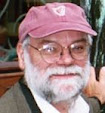“Na Trí Mhuicín” [a
portion of the story] “The Three Little Pigs”—In Irish
Gaelic
1. Bhí na trí mhuicín ina suí go moch ar maidin.
Chuaigh siad amach ag
obair.
[The three little pigs were sitting early in the morning.
Then they went out to work.]
2. Rinne Dónall
Muicín teach beag tuí.
Rinne Colm Muicín
teach beag adhmaid.
Rinne Brian Muicín
teach beag bríce.
[Little Pig Donall made his little house out of straw.
Little Pig Colm made his little house out of wood. Little Pig Brian made his
little house out of brick.]
3. Tháinig an mac tire
gránna go dtí an teach beag tuí.
“Lig isteach mé. Lig
isteach mé, a chara mo chroí,” arsa an mac tire.
[The ugly wolf came to the little house of straw. “Let me
in. Let me in, my dearest,” said the wolf.]
4. “Ní tusa mo
charasa,” arsa Dónall Muicín leis an mac tire gránna. “Ní ligfidh mé isteach
thú. Imigh leat abhaile.”
[You’re not my friend,” said Little Pig Donall to the ugly
wolf. I will not let you in. Go home.”]
5. “Huth! Huth! Hó!” arsa
un mac tire gránna.
“Huh! Huth! Hé!
Séidfidh mé agus leagfaidh mé do theach beag tuí.”
Ansin shéid sé agus
shéid sé agus leag sé an teach beag tuí.
[Huth! Huth! Ho! Said the ugly wolf. Huth! Huth! Hey! I will
blow and I will knock down your little house of straw.” Then he blew and he
blew and he knocked down the little house of straw.]
Approximate pronunciation of the story above (capitalized
syllables receive greater stress):
1. VEE nuh TREE WUCK-EEN in-uh SEE guh MUKH er MAH-jin.
KHOO-ee SHE-ud ah-MAKH egg UH-ber
2. RINN-uh DOH-nal MUH-KEEN CHYAKH BEE-ug TEE.
RINN-uh CAH-lum MUH-KEEN CHYAKH BEE-ug AH-mudge.
RINN-uh BREE-un MUH-KEEN CHYAKH BEE-ug BREE-kuh
3. HAW-nig un MAHK TEER-uh GRAW-nuh guh JEE un CHYAKH BEE-ug
TEE.
LIG ih-SHTAHKH MAY. LIG ih-STAHKH MAY, a KHAR-uh muh KHREE,
AR-suh un MAHK TEER-uh.
4. NEE TOO-suh muh KHAR-uh-suh, AR-suh DOH-nal MUH-KEEN lesh
un MAHK TEER-uh GRAW-nuh.
NEE LIG-ee MAY ih-SHTAHKH HOO. IH-MEE laht uh-WHILE-yuh.
5. HUH HUH HO, AR-suh un MAHK TEER-uh GRAW-nuh.
HUH HUH HAY. SHAY-ee MAY AH-gus LAHG-ee MAY duh HAHKH BEE-ug
TEE.
Ahn-SHIN HADE SHAY AH-gus HADE SHAY AH-gus LAHG SHAY un CHYAHKH
BEE-ug TEE.
It’s hard to write a phonetic transcription without the
International Phonetic Alphabet. But I gave it a try using fairly standard
English spellings. When I used “h” after a vowel, as in “MAHK,” I’m indicating
a lengthening of that vowel. “KH” is being used to show the “ch” sound at the end
of a word like “loch.”


2 comments:
I just found your website and the wonderful job you did with 'Na Trí Mhuicín'. I have been trying for a while to learn a bit of basic Gaeilge here in San Diego and your work here is marvelously useful and helpful. Thanks for doing this.
Jack Foley
rehomes@cox.net
This is the second time I am leaving comments. I am not sure how I have been channeled here but -- anyway if you didn’t get the original comments, I wanted to say I love what you did with ‘Na Trí Mhuicín’. I live here in San Diego and I have been trying to study Gaeilge for a while with very mixed success and what you did here is enormously helpful. Thanks a lot for doing this.
Jack Foley
rehomes@cox.net
Post a Comment